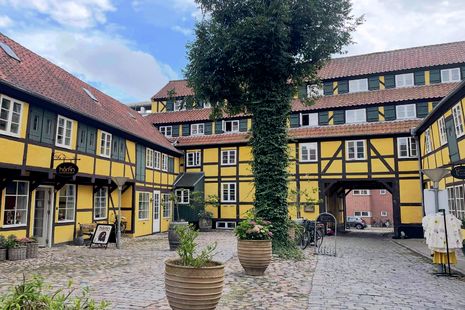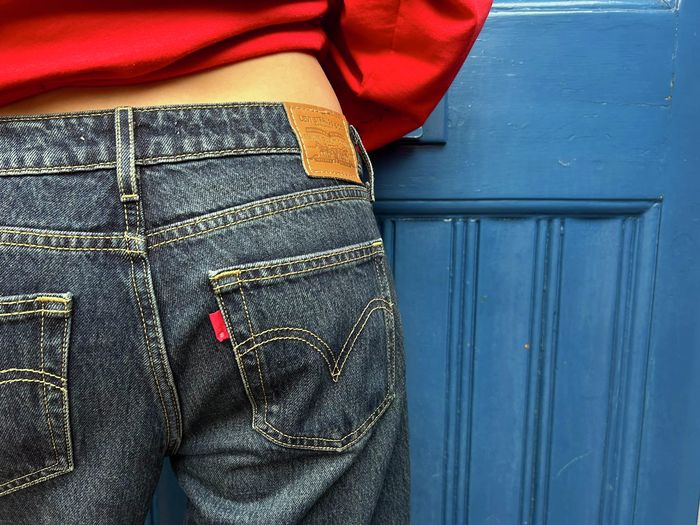Copenhagen Fashion Week was pure fantasy
Matilda Billinge shares her highlights from Copenhagen Fashion Week and questions the banality of Scandi style

Spanning August 5th-9th this year, I found myself ushered into a world of frills and make-believe by Copenhagen fashion week. The delightfully messy silhouettes of Copenhagen native Cecilie Bahnsen’s all-in-white anniversary show, evoking imagery of the runaway bride; the princess and the pea-esque layers and sleep-tousled garments of Nicklas Skovgaard’s Spring 2026 collection; the home country of Hans Christian Andersen appeared to be living up to its fantastical reputation – Copenhagen fashion week had it all.
Another personal highlight included Caroline Bille Brahe’s Caro Editions show; well-aligned with current online trends, the self-described ‘preppy’ pops of colour and polka dots leaned into nostalgic territory, especially when paired with reworked plaid and pre-loved bags (all sourced from classic British brand Mulberry). Edgier scenes were to be found at Anne Sofie Madsen, where rat-shaped bags, black silk and sheer dresses effortlessly blended trashy with high fashion.
“Much to my disappointment, it seemed that the fantasy visions of fashion week had been just that: fantasy”
When the time came to visit the Danish cities of Odense and Copenhagen a month later in early September, I stuffed my 45×36×20 cm cabin bag with my approximation of a capsule wardrobe and jetted off with two friends in tow. Upon arrival, the airport floor provided the perfect people-watching location as we sat and waited for the first of the two trains that would take us to Odense. As the 50th beige trench coat of the half-hour drifted into view, it became abundantly clear that unless I expanded my holiday budget to encompass some serious shopping, my clothing choices were going to stick out like a sore thumb. Much to my disappointment, it seemed that the fantasy visions of fashion week had been just that: fantasy.
“To step outside in Odense wearing a bright green jumper and bootcut jeans felt almost experimental”
What struck me wasn’t the desaturated, minimalist style I was seeing – which, thanks to the popularisation of the ‘Scandi girl’ aesthetic on social media, is far from exclusive to Scandinavia – but the ubiquity of it. To step outside in Odense wearing a bright green jumper and bootcut jeans felt almost experimental. Breaking from the uniform of plain tee, straight-leg jeans, striped overshirt and white trainers identified us as tourists as surely as our inability to speak Danish. Gone were the ethereal dresses of Anne Sofie Madsen, replaced by rows of clothing shops selling near-identical basics in recycled polyester.
“Effortless layering and pops of colour amidst versatile neutrals are the central tenets of the ‘Scandi girl’”
That said, a healthy dose of classic Danish minimalism was to be found amongst the floating fancies of fashion week, so perhaps this should not have come as so much of a surprise. For example, designer Freya Dalsjø presented us with a procession of block greys, creams and blacks, allowing her woven and hand-carved wooden pieces to take centre stage. Furthermore, many of the fashion week shows including Baum und Pferdgarten’s spring 2026 ready-to-wear collection experimented with layering, for example scarves over midi skirts, an art that the Danish seem to have perfected both on and off the runway. In Odense, the ‘Scandi girl’ effect was in full swing; simultaneously playful and put-together, this particular style (as popularised on social media) focuses on classy functionality. Effortless layering and pops of colour amidst versatile neutrals are the central tenets of the ‘Scandi girl’, who is ready to step out of the coffee shop and hop onto her bike at a moment’s notice.
Copenhagen heralded slightly more variation, but perhaps only due to its comparatively larger population size. Walking down Strøget, one of the longest shopping streets in Europe, you could spot some younger residents of the city sporting alternative styles including scene and decora-inspired looks. However, I dare say that the boldest fashion statements we encountered on this stroll were the matching kilts of the Scottish football supporters who had commandeered every pub in the capital. (Obviously we had missed the memo there.)
It seemed that in spite of the exceptional creativity and experimentation exhibited throughout Copenhagen fashion week, on the streets of Odense and Copenhagen, the everyday style left much to be desired in the way of individuality. As aesthetically appealing as the ‘Scandi girl’ aesthetic may be, it’s hard to believe that personal expression factors into these copy-paste outfits. Although the Danish certainly know how to dress coherently, with their limited colour palettes and sleek silhouettes, I would argue that truly exceptional style requires an element of daring which I found to be sorely lacking during my trip. Therefore, the Scandi style remains, at least to my eye, undeniably boring.
 News / Cambridge students accused of ‘gleeful’ racist hate crime4 December 2025
News / Cambridge students accused of ‘gleeful’ racist hate crime4 December 2025 News / Churchill announces June Event in place of May Ball3 December 2025
News / Churchill announces June Event in place of May Ball3 December 2025 News / Cambridge cosies up to Reform UK30 November 2025
News / Cambridge cosies up to Reform UK30 November 2025 Comment / Don’t get lost in the Bermuda Triangle of job hunting 24 November 2025
Comment / Don’t get lost in the Bermuda Triangle of job hunting 24 November 2025 News / Uni redundancy consultation ‘falls short of legal duties’, unions say6 December 2025
News / Uni redundancy consultation ‘falls short of legal duties’, unions say6 December 2025









